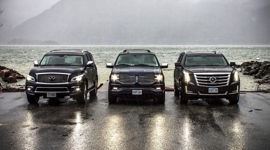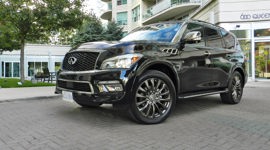 AutoTrader SCORE
AutoTrader SCORE
-
STYLING5/10
-
Safety8/10
-
PRACTICALITY9/10
-
USER-FRIENDLINESS7/10
-
FEATURES9/10
-
POWER8/10
-
COMFORT9/10
-
DRIVING FEEL7/10
-
FUEL ECONOMY5/10
-
VALUE7/10
Let’s start by addressing the elephant in the room.
Did we mention it’s big?
The 2017 Infiniti QX80 is the elephant in the room. Or whale. Or given its advanced age (this generation of Infiniti QX has been around with only minor face-lifts for almost eight years now), maybe dinosaur is more apt. The point is, it’s a large rig and to call its styling polarizing would be charitable.
And it’s not just the homely front end, with its headlights seemingly mounted too low for its tall grille and hood that’s off-putting. Nor is it just the tacky-looking afterthought fender vents. It’s the awkwardly tall proportions and general bulbousness that show a lack of elegance, made even more cartoonish by the giant, 22-inch wheels.
Styling is, of course, highly subjective, and there must’ve been a whole team of designers and a committee of executives at Infiniti that thought the Nissan Patrol (overseas, or Nissan Armada here) on which the QX80 is based, was a pretty handsome machine.
So, we’ve addressed that, let’s move on, because there are a few positives to present when talking about the QX80.
If it’s what’s inside that counts, then Infiniti’s full-size SUV suddenly becomes more appealing. The interior of this top-shelf Limited trim QX80 is luxuriously appointed, its lovely quilted truffle-brown leather seats being its most noteworthy asset. The tall thrones are grandly comfortable and help provide a commanding view, and the matte-finish, open-pore ash wood trim is a decadent touch.
That said, where the dash trim meets the door trim, it’s evident that one of the pieces isn’t actually genuine lumber, with a different shade and texture belying its claim to legitimacy.
There are a few ergonomic gaffes as well, such as the buttons to cycle through the trip computer screen nestled between the speedometer and tachometer, that are inconveniently located atop the instrument binnacle. Likewise, the heated steering wheel button is hidden down near the driver’s left knee, while the heated and cooled seats are operated by a tiny dial at the bottom of the central dash that’s easily overlooked, resulting in surprisingly warm or cold buns, often at times when such sensations weren’t called for.
While the actual knobs and buttons for the climate and audio controls are very much appreciated, the infotainment system itself utilizes Infiniti’s dated and cumbersome rotary dial system. The screen is sufficiently large though, and the graphics are decently bright and cheerful, and the sound system is rich and powerful, but the controls show the big Infiniti’s age.
The second-row captain’s chairs are divided by a large console that contains the headphones for the front-seat headrest screens. Leg and headroom in this second row is generous, and certainly four sizable adults could travel vast distances with an abundance of luggage, and in comfort. Less costly models can be fitted with a three-person bench seat in the second row, but the twin thrones seem more appropriate for a vehicle with such luxury.
If travelling with three more folks, it’s best to make sure they’re of a smaller stature. The third-row seat has belts to contain three people, but the bench’s width suggests it’s best suited to children or emaciated grown-ups. The second-row captain’s chairs do a clever flip and fold trick to allow easier access to the back of the bus.
Cargo capacity is great when the third row isn’t in use, and still reasonable to contain a few full-size suitcases even when it is in use. With all the seats folded down, it’s darn near cavernous in the back of the QX80.
If space – either for people or cargo – is a primary concern, the Infiniti overshadows its primary competitors in the full-size SUV segment. Inside and out, the Infiniti even trumps the gargantuan Cadillac Escalade in every dimension and capacity except for exterior width.
Did we mention it’s big?
Plus, with a 755 kg payload capacity and an impressive 3,856 kg towing capacity, the QX80 also out-hauls its rivals. It’s big and it’s tough.
Thanks to its great outward visibility, the size is surprisingly easy to manage in most settings. And truthfully, it’s no larger than the full-size pick-up trucks that are so popular in both rural and urban locales.
And while the rolling elephant isn’t exactly graceful in aggressive cornering manoeuvres, it isn’t expected to be, and still actually manages itself at least as well as the big GM rigs. A full-size (and much lighter) Range Rover will make for a better dance partner, but it’s not as capable as a utility vehicle.
Power from the Infiniti’s 5.6L V8 engine checks in at 400 hp if you’re willing to wring it out to 5,800 rpm – something that’s actually easily and even a little fun to do. Even though this engine has been around awhile, it’s still a very good one. Torque is rated at 413 lb-ft, but again at a surprisingly high 4,000 rpm.
That push and twist is sent toward all four wheels via a seven-speed automatic, and both Snow and Tow modes are available to help optimize shift points (and throttle responsiveness) for specific driving scenarios or conditions. It’s a good system that manages smooth shifts, yet is designed to endure the burdens of a lot of torque, and towing situations.
The power is sent to all four wheels through Infiniti’s All-Mode 4WD, again utilizing computerization to control Auto, 4H and 4L settings.
Fuel efficiency is mid-pack with the Cadillac Escalade and a supercharged Range Rover posting slightly better combined average fuel figures. Lexus’s less powerful LX570 full-size sport utility machine is slightly less efficient despite lower power and torque figures. Specifically, the government rates the Infiniti at 11.9 L/100 km highway, a painful 16.9 L/100 km city and 15.1 L/100 km combined.
Despite the QX80’s impressive utilitarian capabilities, the most compelling reason to consider purchasing one of these beasts, is the value it represents within its class. At a starting price just north of $75,000, the Infiniti is significantly more affordable than the Cadillac Escalade ($96,000), Range Rover ($118,500) and 2017 Lexus LX 570 ($108,000). Even if moving up to our test machine’s Limited trim, the cost is $93,800 (with an extra $750 thrown in for the lovely Hermosa Blue paint).
It’s no small investment, to be sure, but even a similarly equipped GMC Yukon Denali – the Escalade’s low-rent cousin – prices out into the $80,000s and it doesn’t have the same luxury brand cachet. Still, at this level, an emotional appeal, or least some brand cachet is expected to accompany a luxurious and spacious interior – not to mention some utilitarian capability.
The Infiniti is a fine choice for a sizable (and affluent) family that wants to haul a big wakeboarding boat in and out of Lake Rosseau or Okanagan Lake at their 4,000 square foot cottage, and who put practicality and value over panache. In April of this year, Infiniti unveiled the QX80 Monograph concept vehicle that is a decided improvement in the style department and hints strongly at what the next generation of the brand’s big SUV is likely to become.
The last few Infiniti models introduced have been handsome and dynamically impressive, so waiting for the next generation QX80 may be worth it. For buyers looking for something sooner than later, they should at least chase a big discount on the current QX80.
| Engine Displacement | 5.6L |
|---|---|
| Engine Cylinders | V8 |
| Peak Horsepower | 400 hp |
| Peak Torque | 413 lb-ft |
| Fuel Economy | 16.9/11.9/15.1 L/100 km cty/hwy/cmb |
| Cargo Space | 470 L/2,693 L rear seats down |
| Model Tested | 2017 Infiniti QX80 Limited |
| Base Price | $93,800 |
| A/C Tax | $100 |
| Destination Fee | $1,995 |
| Price as Tested | $96,645 |
|
Optional Equipment
$750 – Hermosa Blue Paint $750
|
|














































